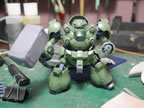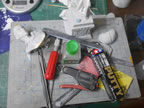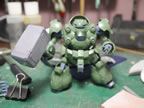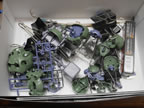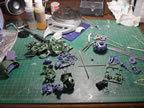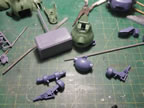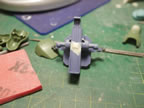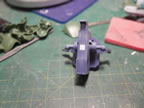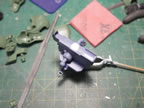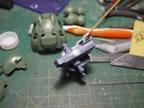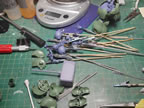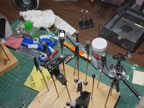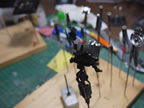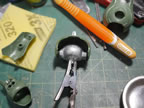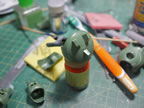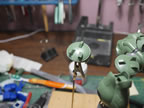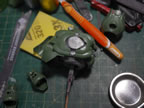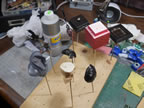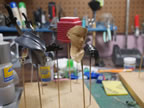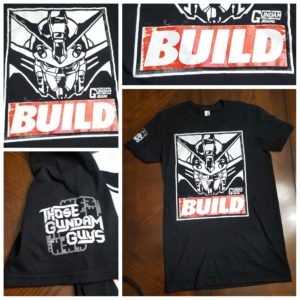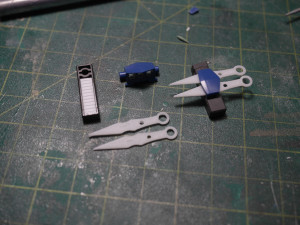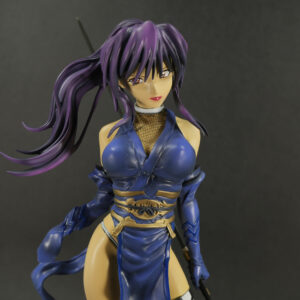Since the workshop is now mostly settled and in full function; I’m starting off the new year with several projects meant for quick builds. The quick builds work to help me make adjustments to the new workshop. Moving sucks. The imagination can plan where things should go; but it’s not until I get down and start working on things that I really get to know how I want the paints placed and tools are placed, etc. I returned to the resin Levi kit to just break in the spray booth and start throwing some paints around. It also worked to vett the new mods to the spray booth and venting system.
We also had a build gathering this past weekend and I wanted to get a new kit to snap; so I went to the local gunpla shops and picked up the 1/144 Gundam Gusion. This chubby green bastard with his giant hammer just called to me.
More updates about the Gusion build as well as painting progression for Levi after the jump.
The hammer is damn cool. I had some fleeting thoughts about doing mods to the kit and adding in some LEDs and such; but the 1/100 scale version of this kit is right around the corner, so I’m saving those mods to that kit when it comes out. For the sake of just getting a kit built and more adjustments to the workshop; I’m going to just OOB this kit.
At the build gathering, I started clipping, sanding, and snapping the Gusion together.
The shoulder pieces, leg pieces, inner arm pieces, and hammer are glued together for the first step to seam work. This is just part of working with 1/144 scale kits. There will be seams. Some tamiya extra thin cement and a little pressure welds the parts together. The plastic ooze needs several hours to cure and set up before sanding and getting the part ready for paint. I have a comparison picture of the before and after for the inner shoulder.
Since the glue needed to set; I put focus on filling pin holes in the resin kit. A hobby knife cuts open the pin holes and tamiya light curing putty is used as the filling agent. The light curing putty really works well over resin, but not so well over plastic. Since the move; I have still not found my tube of basic putty; so my work on the Dougram kit has stopped.
Returning to the Gusion kit; these 1/144 kits and even a good number of 1/100 kits now have a polycap and hole at the bottom of the waist part for display stands. For me, these need to be filled. So I cut some plastic strip and glued it to the area. Then with my new tube of Mr White Putty (since I still haven’t found my tube of tamiya basic putty); the area is puttied. After curing for a day, I sanded it down yesterday during our bi weekly TGG & Friends broadcast.
The other seams sanded down, the parts are placed on skewers and ready for a trip to the spray booth. For the internal frame pieces, I first sprayed a gloss black. Then the shoulder pieces and hammerhead got alclad stainless steel since i liked the blue tint in the metallic. The thruster bells got alclad burnt metal, and the internal frame pieces got alclad steel.
I often get questions about how to build; in relation to parts where there’s a seam within a seam. So the Gusion has a perfect example. The shoulder piece has a inner grey frame piece and an outer green part. There are seams for both these parts. So the question I usually get it, is how to approach this. What I’ve found has worked for me is to first seam up the inner frame piece as well as paint it. Once the paint cures, I used parafilm to mask off the part, then assembled the outer part, gluing it together. And that is all there is to the process; it’s just a matter of breaking it down to atomic steps.
During last night’s broadcast, I discussed this process; if you missed it last night, you can watch it here:
The same process is done for the main body’s internal frame. The frame is painted, then parafilm wrapped and the outer parts are assembled and ready for paint. I do this so that I get consistent paint tones for the two parts. If I painted these parts as separate pieces; there is a higher chance for getting different paint tones.
The inner frame for the arms are masked off and I hand painted in some of the detail areas for the inner frame. Granted I could mask off the part and airbrush in the metallics, but for something so small; I’m perfectly content to just hand brush the little details.
The last bit of work I did last night was spray the base colors for the Levi kit. The eyes were masked off using sticky tac (see the broadcast for that process). The base skin tone, base black for the pedestal parts and hair, and red for the brick area. The sword blades were painted with alclad stainless steel.
Progress is moving for these two projects and hopefully the Dougram kit will get more progression. I’m enjoying the new workshop and slowly getting things set up properly the more it’s used.
